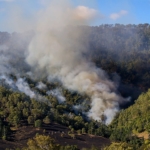
06 Dec Wasps Are About: Here’s What To Do About Them
Have you noticed a steady stream of yellow and black wasps around your home?
They could be European wasps (eWasps), an introduced pest which poses a danger to people. They’re found in the ACT, Victoria, South Australia, New South Wales and Western Australia.
“By November, eWasp queens have come out of hibernation and are establishing nests,” says Christina Bariesheff, Reporting & Communications Officer with CoreEnviro Solutions, which runs the European Wasp Hotline for the ACT Government in Canberra. “An eWasp nest can produce up to 1000 new queens with a survival rate of 30 percent over winter.”
How to spot an eWasp
During the warmer months, there are several types of wasps building nests. While eWasps are a real concern, they are often confused for their very similar-looking cousin, the yellow paper wasp.
The eWasp is generally stouter than a paper wasp, and can be identified by solid black antennae. Paper wasps, meanwhile, are longer and more slender shaped with yellow and black antennae.
The eWasp’s nests can be hard to spot and are typically found in a hole in the ground, roof voids, wall cavities (with the entrance point often around door and window frames), and in conifer trees. You might also find them in the garage or shed, or on fallen logs. Kids playing outside often do not see the holes in the ground that signify a nest, until it’s too late.
Paper wasps, meanwhile, build the more recognisable wasp nests of hexagonal chambers up high in trees, gutters, and door frames.
An attack
If the nest is disturbed, the wasps will emit an alarm pheromone summoning the colony to attack. They will aggressively swarm in large numbers, and sting repeatedly. Unlike the honey bee, eWasps do not die after stinging and do not lose their stinger.
“You will have to get as far away from the nest as possible, around 300m,” advises Christina. The sting causes a burning pain and swelling. Around one in 10 people who are stung twice or more become allergic, which means they will experience severe reactions to any subsequent stings, she explains. Wasp, bee and ant stings can cause anaphylaxis, but this is uncommon. “Effective treatment is available, which involves bee/ant/wasp sting allergy sufferers carrying a special kit when outdoors. Immunotherapy or desensitisation can reduce the severity of the allergy. Seven deaths over a 20-year period attributed to wasp stings have been recorded in Australia, mainly amongst known allergy sufferers who were not carrying their medicine.”
First Aid
- Use a cold pack to reduce swelling and pain.
- Use pain-relieving medication and creams.
- If you seem to be having a more severe reaction, or the sting victim is known to be allergic to wasp and bee venom, seek immediate medical attention.
Control the Issue
To reduce the risk around your home:
- Pick up any fallen fruit from trees.
- Feed pets inside the house or after dark outdoors. Don’t leave uneaten pet food or dog bones outside.
- Fit tight lids to rubbish bins and compost bins.
- Cover your swimming pool when not in use.
- Cover food during a barbecue or picnic.
- Don’t drink straight from a can or bottle when outside, as it could contain a wasp. Alternatively, use clear containers or drink from a straw.
- Inspect your garden weekly for nests from spring to autumn.
- If you see an eWasp, leave it alone – it will only attack if provoked. Get any nests professionally treated.
Waspbusters
You can report nests on the European Wasp Hotline, 02/6258 5551, at ewasp.com.au, or on the eWasp app.



